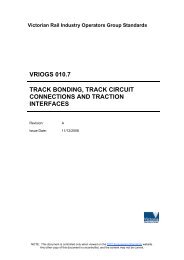VRIOGS 002.1 Railway Station Design Standard and Guidelines
VRIOGS 002.1 Railway Station Design Standard and Guidelines
VRIOGS 002.1 Railway Station Design Standard and Guidelines
You also want an ePaper? Increase the reach of your titles
YUMPU automatically turns print PDFs into web optimized ePapers that Google loves.
<strong>VRIOGS</strong> <strong>002.1</strong> Revision A 196.4 CONSIDERATIONS FOR DESIGN OF TRACK CROSSINGS ANDPLATFORM CONNECTIONSTrack crossings by commuters <strong>and</strong> the general public shall occur either by an underpass(subway) or an overpass (footbridge). Existing l<strong>and</strong>form, terrain, environmentalconsiderations, l<strong>and</strong> use, elevation <strong>and</strong> relationship to adjacent features such as roads<strong>and</strong> associated approaches to a station may dictate whether a station is located eitherunderground, above ground or at ground level <strong>and</strong> thus determine the type of trackcrossing to be used.Whether an underpass or overpass is selected, they should be designed so as to exitdirectly to ground level. When combined with clear sightlines, bright colours, mild grades<strong>and</strong> good illumination, the passive security of the facility can be heightened, generating asense of safety.Factors to consider when determining the type of track crossing are:a) The track clearance to which an overpass (footbridge) shall be constructed. Thetrack clearance shall comply with the clearance requirements detailed in <strong>VRIOGS</strong>001 Structure Gauge Envelopes – minimum clearances for infrastructure adjacentto the <strong>Railway</strong>.b) The topography of the station environment. Including:i. The impacts on the surrounding streetscape, privacy <strong>and</strong> deterrent to theuse of the station for commuters, an overpass or underpass should becarefully measured against the community acceptance;ii. Locations where rail lines are running on embankments an underpass ismore suited in these situations;iii. Locations where rail lines <strong>and</strong> platforms are in cuttings an overpass ismore suited in these situations.c) The requirement to provide an access path that conforms with the DSAPT, whichallows commuters access:i. To <strong>and</strong> from the platform/s.ii. To <strong>and</strong> from the modal interchange/s.iii. To <strong>and</strong> from the station entry/s.The design of DDA Infrastructure Access needs to take into account the failureof any mechanical systems that may be proposed. It is preferential thatvulnerable mechanical infrastructure for DDA access be avoided wherepossible. Reliability of mechanical DDA Access is a major design considerationwhen proposing mechanical/electrical meansd) The requirement to provide a permanent track crossing in addition to providingaccess to the station for commuters.A basic summary on which mode of track crossing is preferable based on the factorsdescribed above is presented in Table 3 Track Crossing modes – Preferred <strong>and</strong> Non-Preferred <strong>Design</strong> Considerations.NOTE: This document is controlled only when viewed on the DOT Engineering <strong>St<strong>and</strong>ard</strong>s website. Any othercopy of this document is uncontrolled, <strong>and</strong> the content may be inaccurate.

















